Noise gate pedals are often overlooked in terms of importance, simply because they don’t produce the dramatic, tone-altering effects of other pedals. However, if you are experiencing noise issues in your signal chain, the importance of these pedals cannot be overstated.
When you use a high-quality noise gate pedal, it allows your other effects to flourish. It’s pointless having a pedalboard filled with effects pedals if electronic hums and buzzing noises diminish the overall quality of your output.
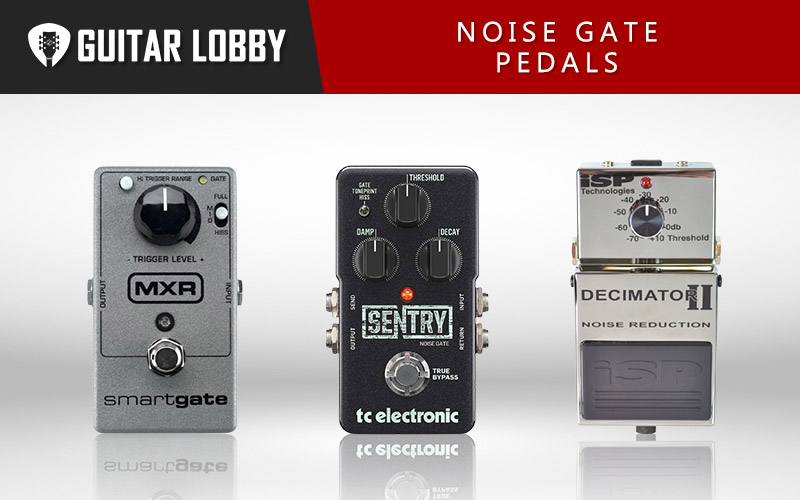
Over the years our team at Guitar Lobby has tested dozens of these pedals, and in this article, we’ll be discussing the best noise gate pedals at each price point. Regardless of your style of playing, you’ll find a choice that is perfectly suited to your requirements.
| Name of Product | Image of Product | Description | Price Range | Full Review |
|---|---|---|---|---|
| 1. ISP Technologies Decimator II (Best Overall) | 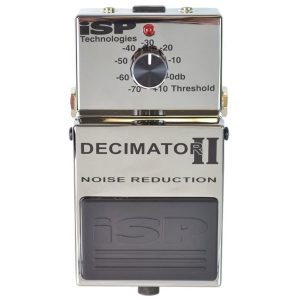 | Type: Digital Effects: Noise Gate | $140 | Read Full Review Below |
| 2. MXR M135 (Best Value) | 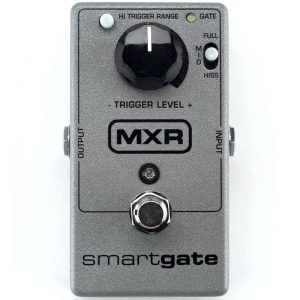 | Type: Analog Effects: Noise Gate | $130 | Read Full Review Below |
| 3. TC Electronics Sentry (Best Under $150) | 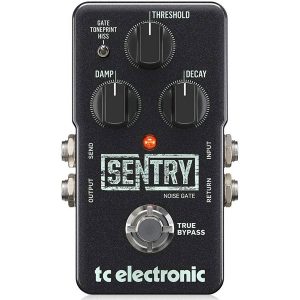 | Type: Digital Effects: Noise Gate | $130 | Read Full Review Below |
| 4. MXR M195 (Best Under $100) | 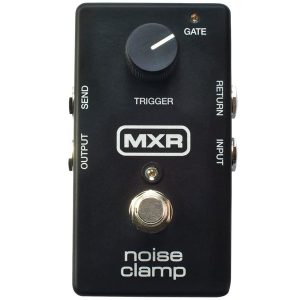 | Type: Digital Effects: Noise Gate | $60 | Read Full Review Below |
| 5. Donner Noise Killer (Best Cheap) | 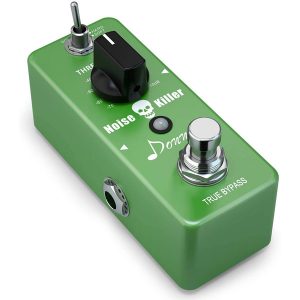 | Type: Digital Effects: Noise Gate | $40 | Read Full Review Below |
| 6. Donner Soph Gate | 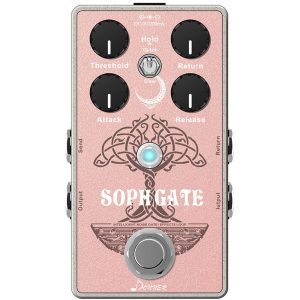 | Type: Analog Effects: Noise Gate | $50 | Read Full Review Below |
| 7. Koogo Noise Gate | 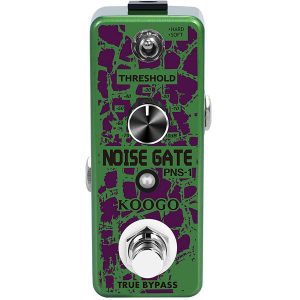 | Type: Digital Effects: Noise Gate | $35 | Read Full Review Below |
| 8. Ebtech HE-2 | 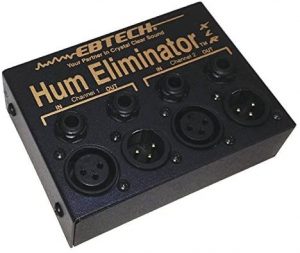 | Type: Digital Effects: Noise Gate | $100 | Read Full Review Below |
| 9. VSN Noise Killer | 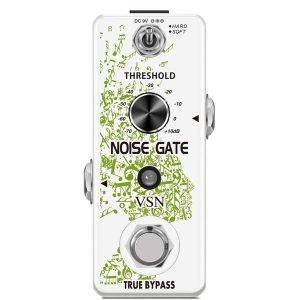 | Type: Analog Effects: Noise Gate | $35 | Read Full Review Below |
| 10. TC Electronic Iron Curtain | 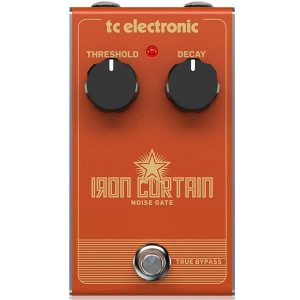 | Type: Digital Effects: Noise Gate | $90 | Read Full Review Below |
| 11. Rowin Guitar Noise Gate | 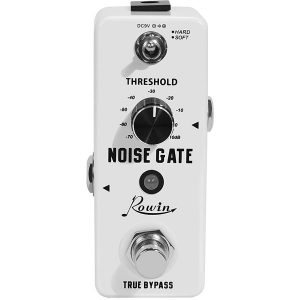 | Type: Digital Effects: Noise Gate | $35 | Read Full Review Below |
| 12. Electro-Harmonix The Silencer |  | Type: Digital Effects: Noise Gate | $85 | Read Full Review Below |
| 13. ISP Technologies DECI-MATE | 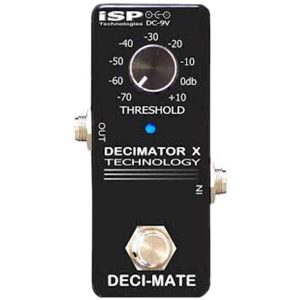 | Type: Digital Effects: Noise Gate | $120 | Read Full Review Below |
| 14. Neewer Noise Gate Pedal | 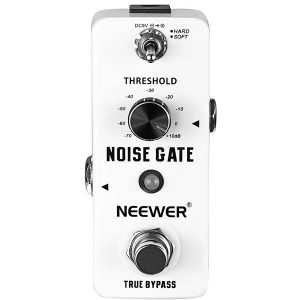 | Type: Digital Effects: Noise Gate | $30 | Read Full Review Below |
| 15. Kymcoco Noise Killer Pedal | 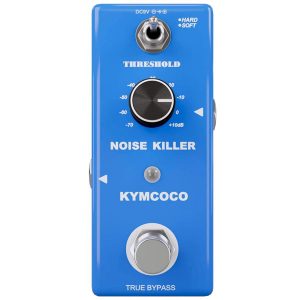 | Type: Digital Effects: Noise Gate | $30 | Read Full Review Below |
| 16. Stax Guitar Noise Gate Pedal | 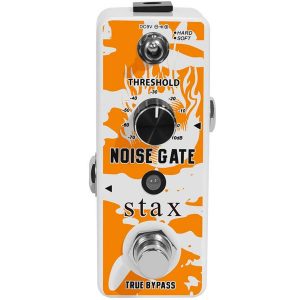 | Type: Digital Effects: Noise Gate | $35 | Read Full Review Below |
| 17. Behringer NR300 | 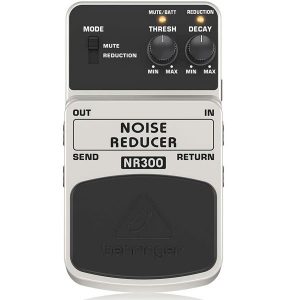 | Type: Digital Effects: Noise Gate | $30 | Read Full Review Below |
Here Are the Best Noise Gate Guitar Pedals
1. ISP Technologies Decimator II (Best Overall)
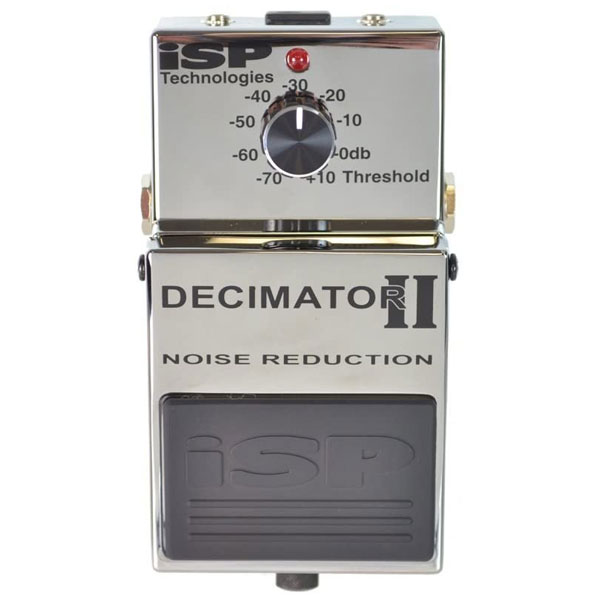
| Estimated Price | $140 |
| Type | Digital |
| Effects | Noise Gate |
| Connectivity | 1 x 6.35mm Jack Input, 1 x Output |
| Power | 9 Volts DC |
My Review: Based upon the success of the original model, I was excited to test out the ISP Technologies Decimator II. My findings were very positive, and I instantly became aware that this is an exceptional noise gate pedal, which I found very easy to operate. It boasts linearized Time Vector Processing, which improves the tracking of the pedal and, I found this to be useful for creating smooth sustain, especially when playing lead guitar parts. Another sing that sold me on this second edition is its ability to completely remove electronic hum, or subtly reduce some unwanted frequencies.
I was pleased to find that the Decimator II, like its predecessor, is built like a tank. Made from a high-strength alloy, it is sure to withstand the rigors of constant use. The threshold control at the top of the pedal allows you to quickly tweak the settings, and I found the large, stompbox pedal design further improved the functionality of this boost device.
The original Decimator was a brilliant noise gate pedal in its own right, but this second edition takes it to a whole other level. The manufacturer added many new features to improve performance, notably to the tracking and the processing power of the new pedal. The standout quality in my opinion is the transparency of the gating effect, with an irresistible clean performance.
Who This is Best Suited for: I would highly recommend the Decimator II to guitarists who want a noise gate pedal that is very simple to operate, but also very capable of removing unwanted noise. With its single-control design, this pedal is very easy to use and doesn’t require any prior knowledge of noise gates.
Bottom Line: The great thing about the ISP Technologies Decimator II, is that despite its simplistic layout, it provides you with complete control over the removal of unwanted noise from your instrument’s signal. Whether you want to eradicate noise from your output completely, or you simply want to minimize the hum that is present when your gain is set high on your amplifier, this pedal will suffice.
2. MXR M135 (Best Value)
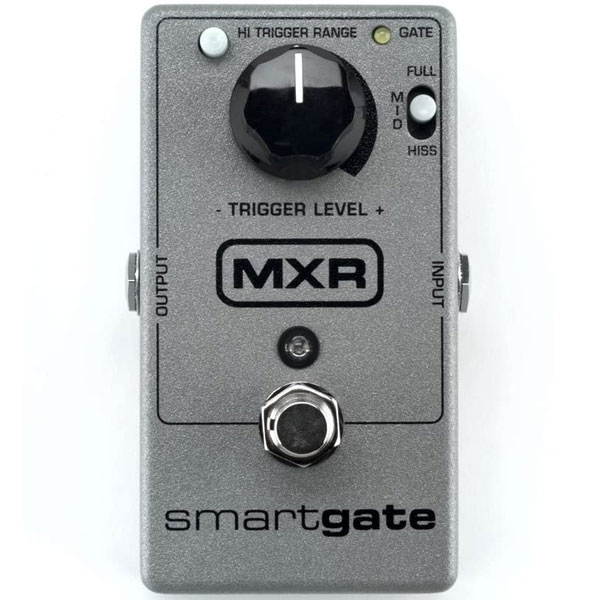
| Estimated Price | $130 |
| Type | Analog |
| Effects | Noise Gate |
| Connectivity | 1 x 6.35mm Jack Input, 1 x Outputs |
| Power | 9 Volt |
My Review: We’re very fond of MXR pedals here at Guitar Lobby, as this Dunlop-owned manufacturer boasts a wide selection of high-quality guitar pedals. Before trying out this pedal, I was already aware that the M135 is their flagship noise gate offering. The first thing that I became aware of was the way the pedal intelligently interacts with a guitar’s signal to preserve the natural tone as much as possible whilst still combating unwanted noise.
Based on my past experiences, the issue with some noise gate pedals is that they tend to be too aggressive in their approach. I find this frustrating as it results in the tone of the instrument being compromised. Thankfully, I found that the M135 doesn’t fall into this category. This is because its design allowed the slight nuances of my playing to be left unscathed by the gating process.
What sold me on the M135 is the way it tracks your signal, and when it recognizes that you’re playing a chord, it reacts slowly, so that the sustain is never hampered in the process. Alternatively, I was impressed to find that when it recognizes more aggressive playing, it kicks into action and adds a solid definition to the output, strengthening the guitar’s tone.
The situation that I found this pedal to be most useful for is when the guitar amp’s gain is set high. In this scenario, the common trade-off is having to contend with hiss and buzzing sounds. The M135 Smart Gate manages to tame these noise issues while keeping the tone of the guitar strong.
Who This is Best Suited for: The M135 by MXR is a great choice for guitarists who play gain-heavy styles of music. Metal and heavy rock guitarists will love the expressive gating that this pedal is capable of producing.
Bottom Line: The standout quality of the MXR M135 is its ability to accurately track your playing and respond accordingly. There are multiple tweakable parameters that you can use to personalize the pedal’s performance. It helps to preserve your tone while still combating unwanted hum and buzz. In my opinion, this is the best noise gate pedal for under $100.
3. TC Electronics Sentry (Best Under $150)
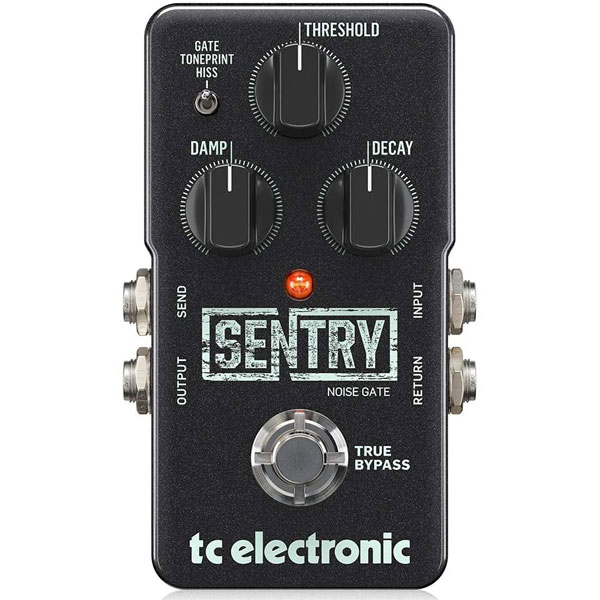
| Estimated Price | $130 |
| Type | Digital |
| Effects | Noise Gate |
| Connectivity | 2 x 6.35mm Jack Input, 2 x Output |
| Power | 9 Volts DC |
My Review: Before encountering this pedal I was already very familiar with TC-Electronics. As a musician, it’s hard to overlook their extensive range of tone-altering effects pedals. It came as no surprise to me that they also offer a high-end noise gate pedal, the revered Sentry.
With cutting-edge multiband technology provided by the System 6000 algorithms, Sentry impresses with its authentic, smooth, and responsive noise reduction. Compared to other similarly priced pedals, I found one area in which it excels is the way its organic delay remains intact and prevents abrupt cut-outs from occurring.
When designing the Sentry, TC Electronic started with a standard blueprint designed to reduce noise issues. Furthermore, the aspect of this pedal which sets it apart from similar options is its impeccable “hard-gate” mode. I believe that this feature is most useful for playing riffs in the lower or mid-range of the guitar.
Who This is Best Suited for: The Sentry by TC Electronic is the perfect noise gate pedal for guitarists who don’t want their natural tone to be compromised when unwanted noise is being reduced. With a specialized Send/Return loop, you can use it to deal with particularly noisy pedals.
Bottom Line: TC Electronics are renowned for designing their pedals with extra care, and the Sentry is the perfect illustration of this. It features two modes – Multiband and Hard Noise Gate. There’s also the inclusion of the renowned Tone Print Editor software which allows you to hook the pedal up to a computer and gain access to a range of downloadable presets.
4. MXR M195 (Best Under $100)
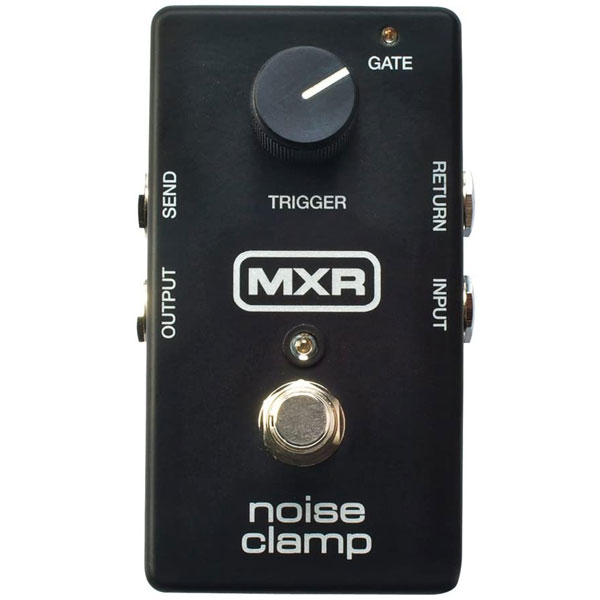
| Estimated Price | $60 |
| Type | Digital |
| Effects | Noise Gate |
| Connectivity | 2 x 6.35mm Jack Input, 2 x Output |
| Power | 9 Volts DC |
My Review: After analyzing this device, I can safely say that MXR’s M195 is an affordable, simplistic noise gate pedal that performs to a high standard. It is designed to keep hiss, hum, and buzz to an absolute minimum. I learned that to achieve this, it uses a sophisticated inner circuitry composition and has its very own effects loop.
The inclusion of an exclusive effects loop is one of my favorite features of this pedal. If, like me, you value a low-noise output, you’ll love the way this pedal allows you to kill any unwanted noise across your whole signal chain instantaneously.
Another feature I was impressed by is the Trigger knob, which allows you to set the threshold of the noise clamp, depending on how much you want to allow the natural tone to breathe. I found the noise clamp to be highly useful for controlling wild tones created by modulation or delay pedals.
The main quality which makes the M195 unique is its exceptional ability to interact with high-gain pedals in your signal chain. In some ways, this pedal is an evolved version of the popular M135, however, it features a more simplistic design and additional connectivity options which come in handy when creating effects loops.
Who This is Best Suited for: The MXR M195 is ideal for guitarists who like to use a lot of gain. It is capable of reducing noise by an impressive 26dB, making it perfect for high-energy tones.
Bottom Line: With a green LED indicator, a simple Trigger control, and its own effects loop, the MXR M195 is a high-quality noise gate pedal at a very fair price. It may not feature the multitude of adjustable parameters that other pedals offer, but it performs very reliably and reduces the noise from your signal with commendable effectiveness.
13. Donner Noise Killer (Best Cheap)
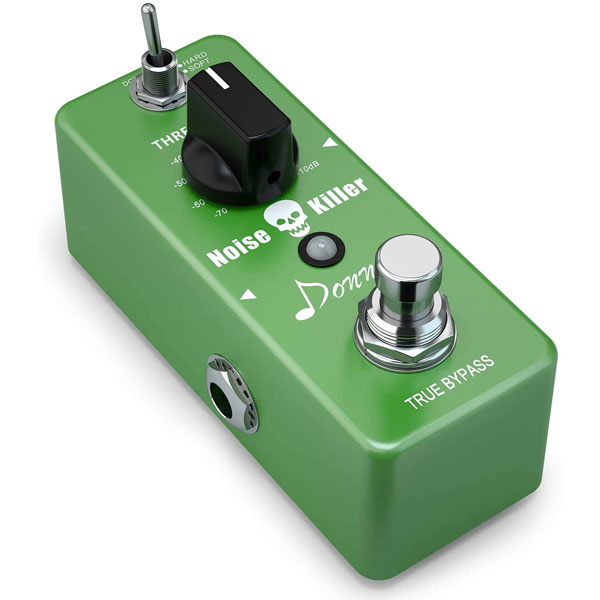
| Estimated Price | $40 |
| Type | Digital |
| Effects | Noise Gate |
| Connectivity | 1 x 6.35mm Jack Input, 1 x Output |
| Power | 9 Volts DC |
My Review: In recent years, I’ve enjoyed watching Donner’s range of affordable pedals expand to cover every type of effect you can think of. In my opinion, the Noise Killer is arguably their best gating pedal, which offers smart, quick noise detection and a smooth attack/release.
The first thing that stood out to me about this pedal is that the casing of the Noise Killer is solid and robust, constructed from aluminum alloy. Donner has also used true bypass switching for tonal clarity preservation when the pedal is switched off.
One thing I found to be useful about the LED indicator that signifies the status of the pedal, is that it allows the pedal to be used even in dark settings. I was also impressed by the two switchable modes, which offer a quick way to change the gating intensity.
Compared to other low-cost gate pedals, this Donner device excels in terms of sound quality. If you use single-coil pickups that tend to produce noise when used with high-gain effects pedals or an overdriven amp, I believe there are very few products that can compete with the Noise Killer in its price range.
Who This is Best Suited for: If you want a high-quality noise gate pedal but don’t have a large budget, the Donner Noise Killer is a pedal worth considering. It’s very easy to use thanks to the single-control layout, and due to its robust chassis, it’s a good choice for the touring musician.
Bottom Line: Durable and reliable, Donner’s flagship noise gate pedal, the Noise Killer, performs at a standard you might expect from a much pricier offering. It features two selectable modes: Hard and Soft, which give you an instantaneous platform for adjusting the pedal’s characteristics. If you have a tight budget, this is one of the best cheap noise gate pedals out there. That said, there are some other great budget options on this list.
5. Donner Soph Gate
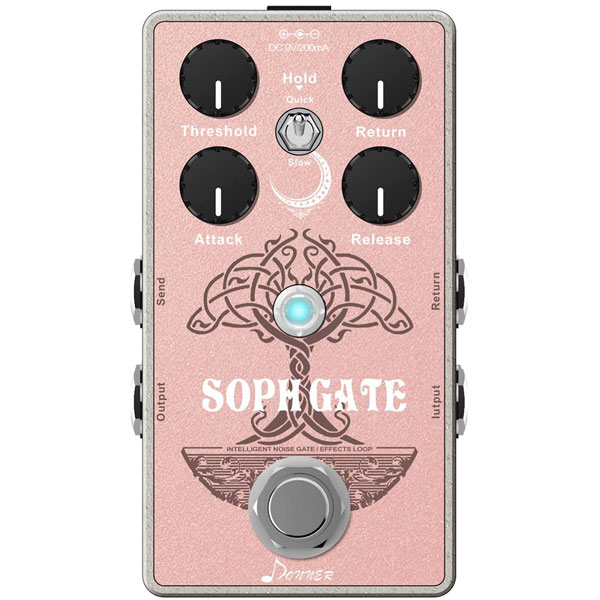
| Estimated Price | $50 |
| Type | Analog |
| Effects | Noise Gate |
| Connectivity | 2 x 6.35mm Jack Input, 2 x Output |
| Power | 9 Volts DC |
My Review: When I first got my hands on one of these, my initial impression was that it was a fairly basic pedal. However, I was pleased to discover that the Soph Gate is an intelligent noise-reducing pedal that features four individual parameters, a switchable preset selector and true bypass switching.
Using a noise gate algorithm, this pedal can identify the sounds that you wish to remove from your output depending on the settings you choose. I found this feature to be particularly useful when another pedal in the signal chain is causing unwanted noise and needs reducing without weakening the overall tone. With Threshold, Attack, Release, Hold and Return controls at your disposal, there are endless possibilities.
The Soph Gate is an evolved version of the Noise Killer, and it stands out due to its extensive selection of adjustable parameters. Compared to other affordable noise gate pedals, this product offers more flexibility for you to find the perfect settings to suit your personal rig. This additional freedom will be invaluable as your selection of effects pedals increases over time.
Who This is Best Suited for: If you’re looking for a high-quality, detailed noise gate pedal but would rather not spend a small fortune, the Donner Soph Gate is worth considering.
Bottom Line: With several adjustable parameters, dual-outputs and its very own effects loop, the Soph Gate by Donner is a wonderful pedal for minimizing unwanted noise. It has true bypass switching for tonal preservation and is housed in a rugged metal chassis for longevity.
6. Koogo Noise Gate
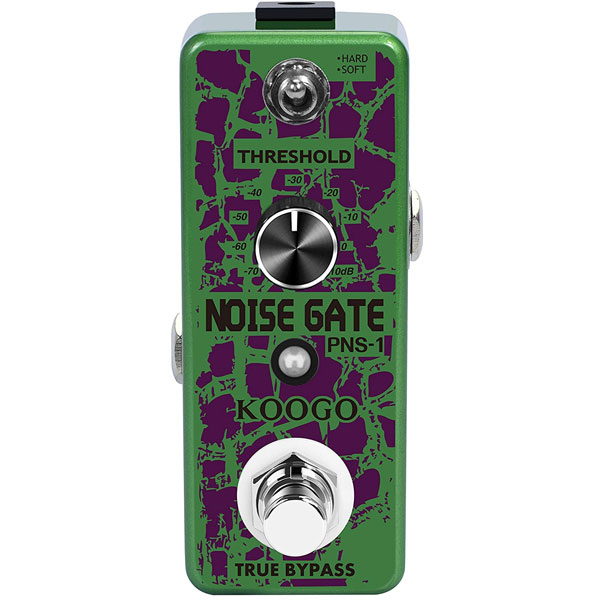
| Estimated Price | $35 |
| Type | Digital |
| Effects | Noise Gate |
| Connectivity | 1 x 6.35mm Jack Input, 1 x Output |
| Power | 9 Volts DC |
My Review: Koogo’s Noise Gate pedal may be fairly minimalistic compared to more expensive models, but we were impressed by the way it still provides a reliable reduction of unwanted frequencies. With two modes that can be toggled using the onboard switch, I found the ability to choose between hard or soft gating depending on this situation very useful indeed.
There’s also the main control, which is located in the center of the pedal and allows you to adjust the Threshold. This simple layout may not be as flashy as some of its competitors, but I actually think that in this case, simplicity is a strength. The pedal uses true bypass switching to retain tonal integrity, even when it is not being used, which is great if you use many pedals at once as I do.
If I had to choose one quality that makes the Koogo Noise Gate stand out, it would be the ease with which it can be used to clean up a guitar’s signal. Admittedly, there are many more complex gate pedals on the market, but sometimes having a multitude of controls at your disposal can overcomplicate things. This pedal is an example of why simplicity is often beneficial.
Who This is Best Suited for: Koogo’s Noise Gate pedal offer guitarists an affordable way to minimize unwanted noise. It’s an ideal choice for musicians who perhaps lack experience with effects pedals and are looking for an easy introduction to noise gating.
Bottom Line: With true bypass switching, an LED status indicator and two distinctive modes, the Noise Gate pedal by Koogo is a capable offering. It is made from high-quality zinc alloy and allows you to reduce noise by up to 10dB.
7. Ebtech HE-2
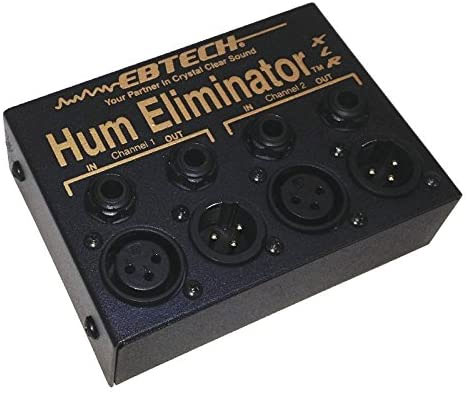
| Estimated Price | $100 |
| Type | Digital |
| Effects | Noise Gate |
| Connectivity | 2 x 6.35mm Jack Input, 2 x Output |
| Power | 9 Volts DC |
My Review: Right off the bat, I was impressed by the high-quality transformers, isolated circuits, and multiple in/outputs. It didn’t take long for me to realize that the Ebtech HE-2 is a sophisticated noise gate pedal. It is capable of automatically reading signal voltages to match any variations in-ground loops, and I found this to be useful because it avoids clipping or harsh gating.
To achieve this clean gating effect, the HE-2 automatically converts your signal between unbalanced and balanced lines. This reactive quality was something that sold me on this particular model, as it ensures that your tone remains natural-sounding, whilst stopping any wanted sounds in their tracks.
Due to the unique design of the Ebtech HE-2, it’s easy to identify the qualities which set it apart from other devices. Rather than following the conventional stompbox design of many noise gates, this device targets hum which comes from any audio source. It can be used for balanced or unbalanced signals, and therefore offers the opportunity to clean up a microphone, preamp, or instrument’s output with equal competence.
Who This is Best Suited for: Ideal for musicians who use a lot of effects pedals, the Ebtech HE-2 features several impressive capabilities. If you regularly experience issues caused by ground loops and pedal power inconsistencies, this noise gate is a great way to solve these problems.
Bottom Line: Boasting exceptional inner circuitry and responsive voltage reading, the Ebtech HE-2 is no ordinary noise gate pedal. It safely breaks any ground loops while preserving your signal as much as possible.
8. VSN Noise Killer
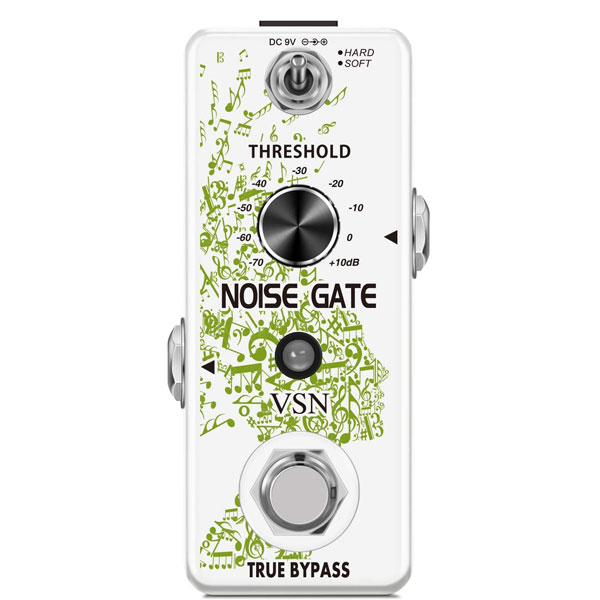
| Estimated Price | $35 |
| Type | Analog |
| Effects | Noise Gate |
| Connectivity | 1 x 6.35mm Jack Input, 1 x Output |
| Power | 9 Volts DC |
My Review: I’ve watched with admiration as VSN has gone from being relatively unknown to one of the leading suppliers of affordable effects pedals in a short period. With its interesting aesthetical design and easy operation, it became clear to me that their Noise Killer performs to a level that belies its modest price tag.
In the center of the pedal, you’ll find a large rotary control that can be used to set the threshold of the gate. Located above this control is a switch, which toggles between Hard and Soft mode. I found these modes to be particularly useful when playing chords, using the Soft mode to allow my tone room for expression, and when playing a solo, the Hard mode will ensure maximum clarity.
For the price, the VSN Noise Killer gates a guitar’s signal with commendable precision. Using their standard stompbox design, the manufacturer has clearly made developments in order to improve the performance of this pedal without raising its cost too much. This combination of affordability and reliability is what sets the Noise Killer apart from other similar products.
Who This is Best Suited for: For guitarists who perhaps want to save some money to purchase other effects pedals in addition to a noise gate, the VSN Noise Killer is a great choice. It reduces noise from your signal without harming the quality of your natural tone and is very easy to familiarize yourself with.
Bottom Line: With Hard and Soft modes that can be toggled using the onboard switch, and a Threshold control, the VSN Noise Killer provides you with everything you need to start successfully gating your guitar’s output.
Popular Related Article: The Best Looper Pedals on the Market Right Now
9. TC Electronic Iron Curtain
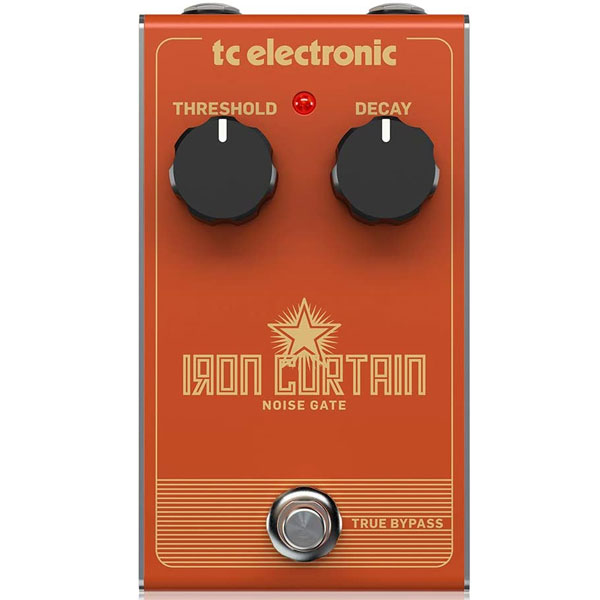
| Estimated Price | $90 |
| Type | Digital |
| Effects | Noise Gate |
| Connectivity | 1 x 6.35mm Jack Input, 1 x Output |
| Power | 9 Volts DC |
My Review: The appropriately named Iron Curtain by TC Electronic impressed me with its ability to quickly remove any unwanted noise from a guitar’s signal. It features an easy-to-operate 2-knob design. These knobs are used to control the Threshold and Decay settings, and I found them very straightforward.
The inclusion of the Decay control is one of the things I found to be especially useful. If, for example, you are playing rung-out chords on your guitar, the notes must be allowed time to breathe before being gated. By setting the Decay to a high level, I discovered that this will ensure that the notes have enough time to sound natural and expressive with no sudden cut-outs.
I must admit, seeing the term “all-analog” used to described effects pedals has lost its impact a little. I love analog technology, but I’ve found on many occasions that it doesn’t necessarily correlate to quality. However, what sets the Iron Curtain apart is that it genuinely does perform to the standard that this vintage circuitry was designed to inspire. Combined with a tube amplifier and high-gain pedals, it works tremendously!
Who This is Best Suited for: If you’re looking for a simple but effective noise gate pedal, the TC Electronic Iron Curtain might be a perfect choice. It features a pair of controls that give you enough freedom to tweak the characteristics of the gating.
Bottom Line: TC Electronic is a reputable provider of high-quality effects pedals, and the Iron Curtain further reinforces this. With a simplistic design, it’s surprising how much room for maneuver this pedal allows when it comes to gating your output.
10. Rowin Guitar Noise Gate
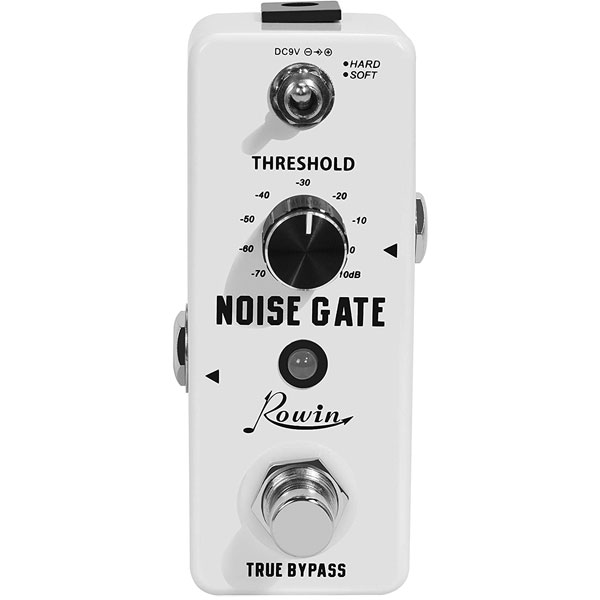
| Estimated Price | $35 |
| Type | Digital |
| Effects | Noise Gate |
| Connectivity | 1 x 6.35mm Jack Input, 1 x Output |
| Power | 9 Volts DC |
My Review: My first impression of Rowin’s Guitar Noise Gate is that it is clearly a minimalistic pedal, but furthermore I found that it performs the basic functions required for suppressing unwanted hum and buzz. With two distinctive modes and true bypass switching, it operates smoothly and reliably.
The switch at the top of the pedal allowed me to choose between Soft and Hard modes. Then there’s the large Threshold control in the middle of the pedal, which is useful because I realized can be used to set the dB rating that the noise gate is activated at.
The Noise Gate by Rowin is very similar to other pedals in its affordable price range. It does the job reliably, without any flashy features or overcomplications, and this is perhaps its main selling point.
Who This is Best Suited for: Reliable, affordable, and easy to use, the Rowin Guitar Noise Gate pedal is a great choice for those who are on a tight budget, or value simplicity. It is housed a high-strength zinc alloy, so if you are likely to use the pedal extensively, its robustness will be of value to you.
Bottom Line: The Guitar Noise Gate pedal by Rowin combines easy operation with responsive noise reduction. Featuring true bypass switching, an LED status indicator, two switchable modes, and a Threshold rotary control, this pedal performs to a very high standard despite its low price.
11. Electro-Harmonix The Silencer
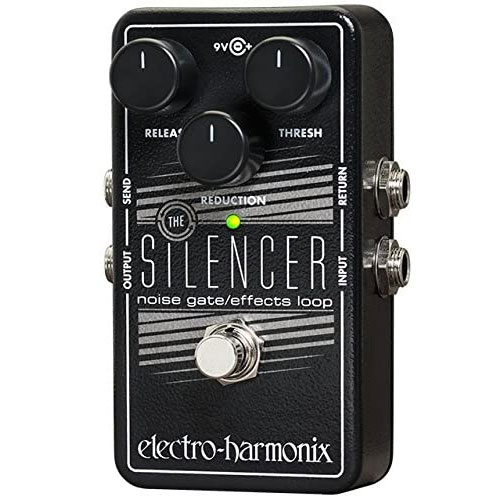
| Estimated Price | $85 |
| Type | Digital |
| Effects | Noise Gate |
| Connectivity | 2 x 6.35mm Jack Input, 2 x Output |
| Power | 9 Volts DC |
My Review: The Silencer is another reminder of the class Electro-Harmonix. I was taken aback by this sophisticated noise gate pedal, finding that it can be used to reduce noise from a single effect or the entire effects loop. With a three-control layout, I was able to adjust the characteristics of the gating to suit my needs at any given moment.
The three onboard controls are Release, Threshold, and Reduction. By adjusting each of these parameters, I was able to set the gating to affect the exact amount of noise that is desired. The pedal also offers dual inputs and outputs and uses true bypass switching to protect tonal integrity when it is not being used, a must-have quality in my opinion!
The abundance of adjustable features is definitely one of the things which separate the Silencer from other similar noise gate pedals. It provides more flexibility than your average gating device, but in typical EHX fashion, it’s very easy to grips with.
Who This is Best Suited for: Guitarists or bassists who are looking for detailed control over the gating process will love the EHX Silencer. Its trio of controls provides you with the platform to create the ideal amount of gating to suit your effects rig.
Bottom Line: The Electro Harmonix Silencer is amongst the best noise gate pedals on the market. It combines buffered circuitry with true bypass, for maximum tonal preservation. It also offers between 8 milliseconds and 4 seconds of release time and is housed in a compact, rugged chassis.
12. ISP Technologies DECI-MATE
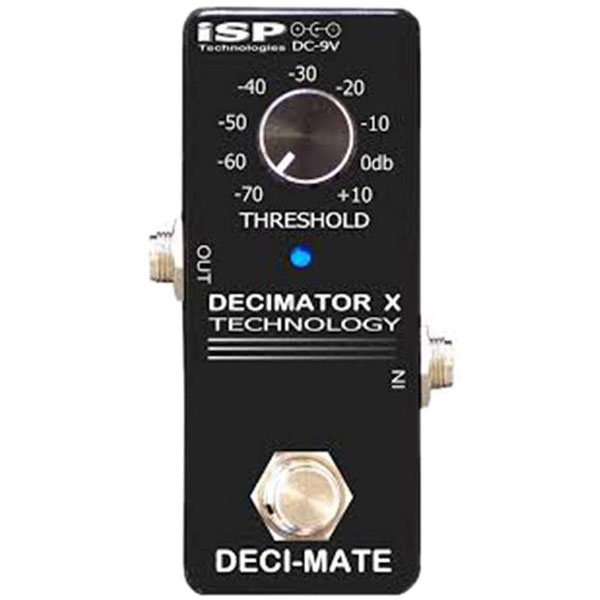
| Estimated Price | $120 |
| Type | Digital |
| Effects | Noise Gate |
| Connectivity | 1 x 6.35mm Jack Input, 1 x Output |
| Power | 9 Volts DC |
My Review: The DECI-MATE by ISP Technologies is a compact noise gate pedal that uses complex inner circuitry to produce clean and effective noise limiting. Its ability to track the signal of an electric guitar, and respond to the settings that are selected, makes it a very capable offering.
Admittedly, I found that although DECI-MATE may not be crammed with controls and parameters, the simple function that it performs is of a very high standard. The threshold can be adjusted based on the number of decibels you wish to gate from your output and I enjoyed the responsive noise reduction that this results in.
The world-renowned “Decimator” circuit inspired ISP to create this noise gate pedal. They took the basic idea of that circuitry, then began to add improvements to its tracking capabilities. This process took them many years of tweaking and adjusting, but the end result was worth it. This pedal’s exceptional tracking makes it great for super-fast staccato guitar.
Who This is Best Suited for: Guitarists who are mostly concerned with maintaining their tonal quality should strongly consider the ISP Technologies DECI-MATE. It’s an ideal choice for those who value simplicity over complexity when it comes to effects pedals.
Bottom Line: Featuring inner circuitry of the highest standard, the DECI-MATE by ISP Technologies performs the noise gating function flawlessly. It has a large Threshold control situated in the center of the pedal and uses true bypass switching to protect the quality of your instrument’s output at all times.
Popular Related Article: The Best Electric Guitars (All Price Ranges)
14. Neewer Noise Gate Pedal
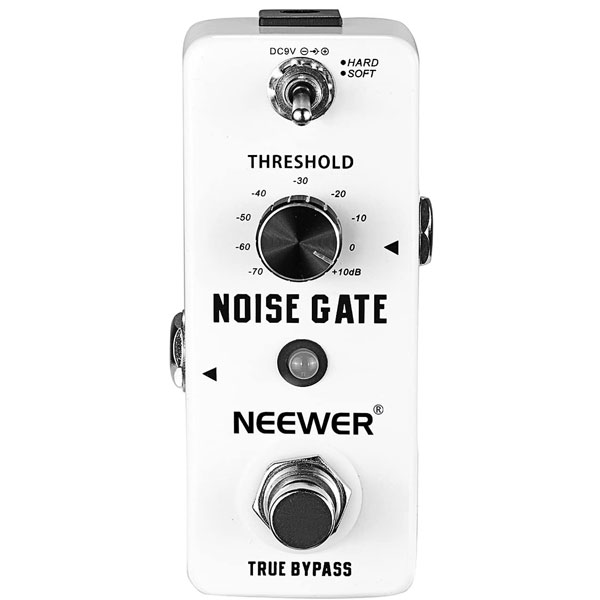
| Estimated Price | $30 |
| Type | Digital |
| Effects | Noise Gate |
| Connectivity | 1 x 6.35mm Jack Input, 1 x Output |
| Power | 9 Volts DC |
My Review: When we first got our hands on the Neewer Noise Gate Pedal, we fell in love with this minimalistic offering from an ever-growing manufacturer. House in a solid aluminum chassis, this pedal provides you with a pair of modes that quickly tailor the responsiveness of the gate.
One of the standout features I really enjoyed about this pedal is the LED indicator that allows you to quickly see the on/off status of the pedal, and also true bypass switching has been included to maintain the clarity of your clean tone at all times. The noise can be reduced by up to 10dB, which is more than enough for my requirements.
Who This is Best Suited for: Affordable and easy to use, the Noise Gate Pedal by Neewer is a perfect choice for those who are perhaps not very experienced with effects pedals. It provides a great way to learn about the functions of noise gating.
Bottom Line: Granted, the Noise Gate Pedal by Neewer may not feature the array of sophisticated controls found on more expensive pedals, but it performs the function of suppressing unwanted noise very capably indeed. True bypass switching ensures that your signal integrity remains intact, and two dual-controls give you plenty of freedom when adjusting the settings.
15. Kymcoco Noise Killer Pedal
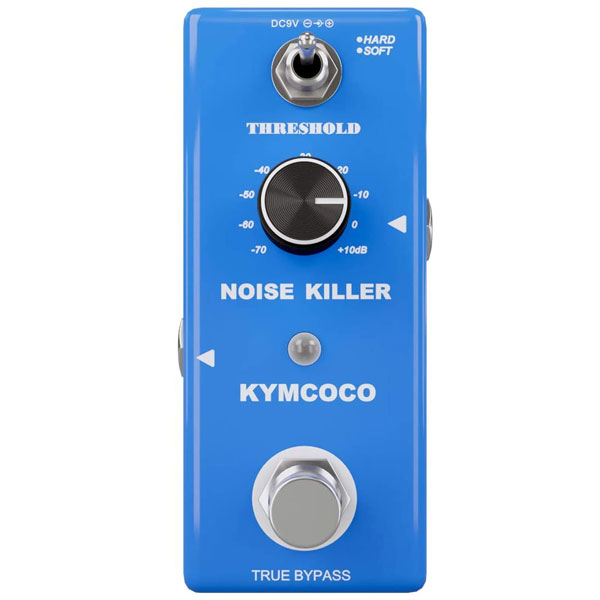
| Estimated Price | $30 |
| Type | Digital |
| Effects | Noise Gate |
| Connectivity | 1 x 6.35mm Jack Input, 1 x Output |
| Power | 9 Volts DC |
My Review: Kymcoco’s Noise Killer Pedal tames the signal of your guitar, minimizing any unwanted noise caused by signal inconsistencies of high-gain settings. I liked how they included a single Threshold control and a toggle switch for mode selection, both of which take very little time to become familiar with.
Fitted with true bypass switching, I found there to be no danger of your tonal integrity being compromised when you incorporate this pedal into your signal chain. There’s also the inclusion of a clear LED light which indicates the status of the pedal.
Who This is Best Suited for: Musicians who would rather avoid pedals that are complex and difficult to operate will enjoy the Kymcoco Noise Killer Pedal. It’s well suited to all genres and styles of guitar playing.
Bottom Line: With true bypass switching for tonal preservation, an LED indicator, two switchable modes that instantly change the gating effect’s characteristics, and a Threshold control, the Noise Killer Pedal provides reliable suppression of unwanted sounds within your signal.
16. Stax Guitar Noise Gate Pedal
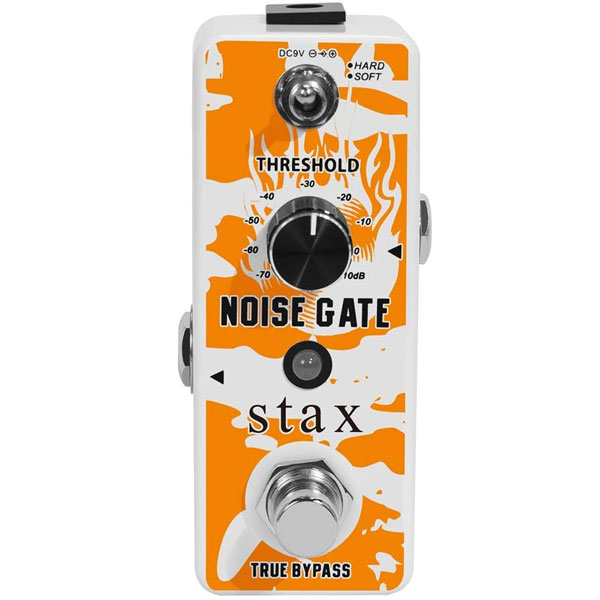
| Estimated Price | $35 |
| Type | Digital |
| Effects | Noise Gate |
| Connectivity | 1 x 6.35mm Jack Input, 1 x Output |
| Power | 9 Volt DC |
My Review: If there’s one thing that jumped out to me about the Stax Guitar Noise Gate Pedal, it’s this pedal’s subtle ability to suppress any unwanted hum or buzz from the guitar’s signal. I was pleased to discover that it can be used to target another pedal, such as high-gain effects like fuzz or distortion, or alternatively, it can position at the end of the signal chain to control the noise from the entire output.
With a smart LED indicator, I was clearly able to see the status of the pedal, and I think this would even be the case on a dimly lit stage. The pedal has two selectable modes, and a large Threshold control positioned in its center which allows you to adjust the number of decibels that are reduced during the gate process.
Who This is Best Suited for: The Stax Guitar Noise Gate Pedal is well suited to guitarists who need a reliable reduction of electronic noise. It’s an affordable pedal, and therefore is a good choice for those who don’t want to spend a lot of money.
Bottom Line: Durable and responsive, the Noise Gate Pedal by Stax effectively removes unwanted noise from your output. With true bypass switching for signal integrity maintenance, and a switch that allows you to select either Hard or Soft gating, this pedal ticks all of the boxes.
Popular Related Article: 17 Must Have Guitar Pedals (with Videos)
17. Behringer NR300
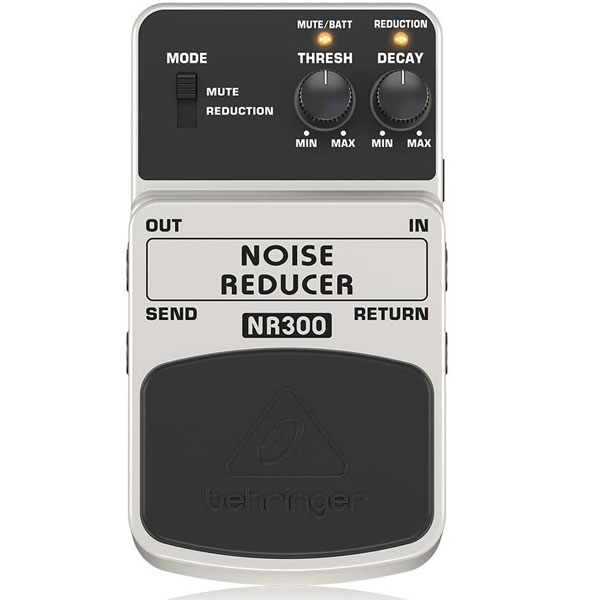
| Estimated Price | $30 |
| Type | Digital |
| Effects | Noise Gate |
| Connectivity | 2 x 6.35mm Jack Input, 2 x Output |
| Power | 9 Volts DC |
My Review: In my opinion, the NR300 by Behringer is a great value noise gate pedal, which caters for signal splitting and can be used to control single effects or your whole effects loop. With two rotary controls positioned along the top row, I was impressed by the ease with which I was able to tailor both the Threshold and Decay settings accordingly.
Another thing I found to be impressive about his pedal was the useful addition of a Mode switch, which includes Mute and Reduction settings. The former completely eradicates any noise from your signal, harshly and extremely. The latter operates less intensely and allows your tone room to breathe.
The only complaint I often hear about Behringer pedals is that they have a tendency to be a little flimsy, and risk breaking when used heavily. However, what sets the NR300 apart, is that it actually feels very sturdy and solid. The pedal mechanism seems to be more robust than other similar devices that I’ve tested, and for that reason, it’s a good choice for hard-working musicians.
Who This is Best Suited for: Affordable and reliable, the Behringer NR300 is a solid choice for guitarists or bassists who want maximum control over the gating effect, without having to break the bank to acquire it!
Bottom Line: Designed to eliminate the dreaded electronic hum and buzz that is caused by high gain amps or pedals, the Behringer NR300 offers solid noise gating with several adjustable settings. Housed in the classic, robust Behringer stompbox design, and with multiple inputs and outputs, this pedal is great value for money.
Choosing the Right Noise Gate Pedal (Buying Guide)
Effects pedals that transform your tone are naturally considered to be more interesting than those that perform subtle functions. That’s why noise gate pedals are commonly overlooked by musicians, but in reality, they are vital components if you want to produce the cleanest sound possible.
The results of a noise gate pedal may be more subtle than distortion, modulation, reverb, or delay effects, but they are just as important. If there is unwanted noise present in your output, this can significantly diminish the effectiveness of your other pedals.
In the following sections of this comprehensive guide, I’ll present you with all of the information you need on noise gate pedals. To make the right decision when choosing your noise gate pedal, you must have a good understanding of what the different controls do, and what is required to produce your desired results.
How Noise Gate Pedals Work
Noise gate pedals work by essentially opening and closing a gate to block out or let through certain sounds. By changing the settings on the pedal, you can determine how much sound is allowed through the gate, and how much you choose to block out.
Like a compressor, noise gate pedals identify the sounds to block out based on their volume. You set the threshold to your desired value, and any sounds that are below that volume will be eliminated from your output.
Setting up a noise gate pedal relies on you to listen and tweak the settings until the right amount of noise has been expelled. You can use them more extremely to emphasize certain aspects of your tone, or you can use them subtly to block out a hint of electronic hum caused by your amplifier. Whichever way you choose to use it, the results will be beneficial to your tonal clarity.
Combining Noise Gate Pedals with Other Effects
The great thing about pedals that perform a subtle function is that they are highly compatible with a selection of other effects. Noise gate pedals are especially versatile because rather than directly altering your tone, they simply remove any unwanted noise that is present in your output.
Pedals that increase the gain of your guitar experience noticeable benefits when paired with a noise gate. These effects include distortion, overdrive, and fuzz. Due to the increase in gain that these effects produce, they are also prone to amplifying any unwanted noise within the signal. Using a noise gate pedal is a great way to minimize the noise and keep your tone as sharp and accurate as possible.
Modulation-based effects also tend to be slightly unpredictable. Although they’re less prone to producing unwanted noise than gain-based pedals, effects like phasers, flangers, and pitch-shifters are liable to increase any noise that is present in your signal. Therefore, positioning a noise gate pedal after these effects will help them to perform to their full potential.
Another type of effects pedal that benefits greatly from the noise-reducing abilities of a noise gate, is reverb and delay. These pedals produce decay which causes the sound to continue after the note has been played. Therefore, if there is any unwanted noise present, this will also be played in the delayed signal. Noise gate pedals take care of it before the noise reaches the reverb and delay.
You don’t need to have a wide selection of effects of your pedalboard to experience the benefits of a noise gate. Even if you have a modest set of pedals, there will still be a significant difference in the clarity and integrity of your tone.
Noise Gate Pedals in the Record Studio
Noise gate pedals are not only useful in a live performance setting. When used in the recording studio, they can help to ensure that the audio you capture is as clean as possible. There a two main approaches you can use when incorporating a noise gate pedal into your recording setup.
These two options consist of either using the noise gate pedal as you would onstage, plugging your instrument into the input, and sending the output directly into your amplifier. The second option is to bypass the amplifier and send the output of the pedal straight into your audio interface, or preamp. Both of these methods offer contrasting benefits and drawbacks that should be considered.
Firstly, using an amplifier provides you with the benefit of translating your onstage tone into your recordings. You can keep the amplifier set up exactly as you have it onstage, which creates consistency and ensures that your live sound doesn’t stray too far from your live sound. The drawback of this method is that you have to use a microphone to record the amplifier’s output into the audio interface. Microphones tend to influence the tone depending on the type that you choose.
Using the second method, you get the cleanest possible sound going into your audio interface, with no coloration caused by the microphone. However, the tone will be influenced by the quality of preamps that are installed on the interface’s inputs. This does allow you to have more freedom when it comes to mixing your recorded audio, though.
Using an amplifier also presents you with the problem of being stuck with the tone that is originally produced. If you record directly into your audio interface, you can always re-amp the recording retrospectively if you decide that it would sound better. This cannot be done using an amp in the first place, so you have less freedom in that respect.
True Bypass and Buffered Noise Gate Pedals
Effects pedals were once renowned for producing noise problems, but as technology has advanced over the past half-century, certain techniques have been devised to keep these issues to a minimum. Noise gate pedals are likely to be fitted with true bypass switching or buffered circuitry. These are the two most reliable methods for protecting signal integrity.
Although true bypass and buffered pedals ultimately share the same end goal – to reduce electronic noise and minimize loss of signal strength, they use different methods to achieve this. You’ve probably noticed that the majority of noise gate pedals listed in this article are of the true bypass variety, but there are some buffered options too.
Let’s start by discussing true bypass noise gate pedals. These are designed to allow the instrument’s signal to flow through the pedal when it is not being used. This results in the pure tone of the instrument being preserved, with no alterations made by the inner circuitry of the pedal. True bypass pedals don’t cause any dynamic changes to the signal. This isn’t an issue if you are using relatively short cable runs, but if you exceed 18.5ft, your tonal integrity is likely to be compromised.
Buffered noise gate pedals use a completely different method to preserve your instrument’s tonal clarity. Unlike true-bypass pedals, they do boost your signal, then drive it through the signal chain, which results in the original tone and dynamics being retained. It doesn’t matter if the noise gate pedal is turned on or off, the process of buffering happens constantly.
If you’re unsure of which type of pedal will be the best option for your needs, here’s my advice. Buffered noise gate pedals are useful if your cable run exceeds 18.5ft in length. This is because they provide your signal with the necessary boost to ensure that it stays strong when being sent through the extensive signal chain. If you’ve got a lot of pedals – buffered is probably your best option.
There’s no reason that you can’t use a mixture of buffered and true bypass pedals. Some would argue that using a combination of these pedal varieties is a safer option than just relying on one type. It’s worth noting that if you do decide to use a blend of the two-pedal types, you should begin your signal chain with a buffered pedal because this will give your clean tone the boost it requires when it is sent to the pedals further down the signal path.
Positioning a Noise Gate Pedal in Your Signal Chain
As your collection of effects pedals grows, you will need to consider the best ways to position them. The order of your effects pedals has a huge impact on the results they produce. Although there are no set-in-stone methods, there are some common rules to abide by if you want to produce the conventional results when using your pedalboard.
By all means, I’d encourage you to experiment with the positioning of your pedal in the signal chain. Many of the most iconic guitar tones have come about as a result of musicians breaking the rules, and discovering interesting combinations. With that being said, it’s advisable to start by using the conventional positioning then tweaking the order afterward.
Noise gate pedals are part of a small group of effects that can be positioned in numerous locations within your signal chain. Your choice should be based on the results you want to achieve. First of all, you should ensure that your other pedals are positioned correctly, then you can experiment with where you place your noise gate pedal.
The conventional positioning of a signal chain is as follows: firstly, you have your tuner, which is followed by dynamic-based pedals such as EQ, compressors, or limiters. Then comes any dirt-based pedals, like distortion, overdrive, or fuzz. After these pedals, it’s advised that you position your modulation effects next in the signal chain. Modulation effects include chorus, flangers, phasers, tremolo, or pitch-shifters. Finally, the signal chain is completed with space-based effects, like delays and reverbs.
There are several positions that you could slot your noise gate pedal into when using this standard ordering. Due to the function that a noise gate pedal performs, you might decide to place it directly after another effects pedal that is prone to producing noise. Gain-based pedals, like distortion or fuzz, are commonly associated with noise issues.
If you have identified a particular effects pedal that is causing your noise issues, then, by all means, slot the noise gate in after it. This will allow the noise gate to directly impact the unwanted frequencies produced by the pedal in question. Alternatively, if the noise is produced by your instrument, then you could place the noise gate at the very beginning of your signal chain.
Alternatively, if you have ambient pedals in your signal chain, like reverb or delay, you could use the noise gate pedal to tame these effects. Positioning the noise gate at the very end of your signal chain will mean that all of the effects are subjected to its presence, and you can control any noise issues presented by your ambient pedals while still getting the full benefits that they produce.
The positioning of your pedals is ultimately a subjective matter that you can tailor to create a unique and original style. It’s a good idea, to begin with, the order that I’ve suggested here, then make adjustments as you go along. If you find a combination that you like, you can rearrange your pedals to accommodate your preferred combinations.
Ordering your pedals in a signal chain provides you with hands-on experience that is a great way to learn about the individual results of different effects. There’s no better way to gain knowledge than simply diving in and physically experiencing the changes that various orders produce.
Noise Gate Pedals with Multiple Outputs
It’s common to find that noise gate pedals offer more than one output. This is a very useful addition to a pedal, especially if your rig includes an extensive selection of effects. Having dual outputs makes signal splitting possible.
Signal splitting, as the name suggests, is the process of making two or more signal paths which can be then sent to different outputs. Many guitarists and bassists use signal splitting to provide them with more control over their clean and effective channels.
If you’re the only guitarist in a band, you might feel that your sound needs thickening in certain areas, especially when your switch from rhythm to lead parts. Using the dual outputs on a noise gate pedal allows you to split your signal, and send your clean tone into one amplifier while your wet signal is sent to a separate one.
This then makes it possible for your clean, unaffected signal to keep playing underneath your wet signal when your noise gate or other pedals are active. Consequently, it creates the illusion that two guitars are playing at once, thus adding more substance to your overall tone.
It’s also common for bass guitarists to use dual outputs. Let’s say you are using a distortion pedal with your bass guitar, rather than losing some of the low-end power that is diminished when using a distortion pedal, you can simply split the signal and allow your clean, low-end richness to remain in the output while the effects channel plays simultaneously.
Not all noise gate pedals facilitate signal splitting, but I included several that boast this ability in the list earlier in this post. If you don’t intend to use a lot of effects, then you probably don’t require dual outputs, but if you would benefit from beefing up your tone, then it’s worth considering.
What Causes Unwanted Noise?
To truly understand the important role that a noise gate pedal plays in your signal chain, we need to establish the main causes of noise issues that make it a requirement in the first place. Realistically, if you don’t know what is causing your unwanted noise, it will be difficult to set up the pedal’s controls to effectively combat the issue.
Unwanted noise can be caused by several factors. One of the main causes is the condition of your amplifier. Solid-state amplifiers are much less likely to produce noise issues, due to their modern inner circuitry. Valve amps are considered to sound better by music purists, but as the valves age, they are prone to producing noise. Setting your amplifier to high-gain is also likely to contribute to the problem.
Generally speaking, the more you boost the volume and gain settings on an amplifier, the more unwanted noise will be present in the output. You can easily reign in the nose using a gate pedal, especially if it has onboard EQ settings.
EQ pedals can also work against you when it comes to producing noise. If you increase the presence of a certain frequency band on the EQ pedal, it is likely to also raise the volume of any noise issues that are located in that range. However, you can also use an EQ pedal to reduce the frequencies that the unwanted noises are located in.
Another contributing factor is the pickups that you use. Single-coil pickups are renowned for producing a lot more noise due to their design. Humbuckers were designed to combat this issue, by literally “bucking the hum.”
Alternatively, you might find that your power supply is another culprit for producing undesirable noise. Low-quality power supplies are likely to emit some electronically-produced hum and buzzing sounds that make their way into the output of your pedals. If you position devices like mobile phones, radios, or other electrical appliances close to your amplifier, this can also result in unwanted noises.
Common Controls Found on a Noise Gate Pedal
Noise gate pedals are essentially dynamic-altering devices. Although there is some variance from model to model in terms of the controls you’re likely to find, most noise gate pedals will feature the following parameters:
- Threshold
- Decay/Release
- Reduction
The threshold parameter on a noise gate pedal controls the extremeness of the effects. It impacts when the gate opens and closes, concerning the signal passing through the pedal. The lower the threshold, the more of the unwanted noise will be cut out, and the higher the threshold, the more noise will get through.
Decay and release controls are also commonly found on noise gate pedals. These parameters essentially adjust the amount of time it takes for the gate to close after it has been opened. If you’re looking for a tight sound, which reduces noise dramatically, you should set the decay low. On the other hand, setting it higher will allows the natural dynamics of the sound source to remain intact.
Finally, reduction is another common control on noise gate pedals. This can be used to adjust the amount of reduction that the signal is subjected to. When this parameter is cranked up, you can expect there to be very little noise present in your signal. Set lower, the reduction is minimized and more of the natural sound gets through the gate.
Multi-Effects Noise Gate Pedals
Although it’s more of a rarity to find noise gate pedals that also produce other effects, there is a handful that is capable of this. Multi-effects pedals are a great choice for musicians who want to access an array of processing options without having an overly crowded pedalboard.
The only issue with choosing multi-effect noise gate pedals over those that exclusively focus on that effect is that the manufacturers are less likely to spend a lot of time making sure the noise gate function as effectively as possible.
They have to split their attention between all of the effects housed within the pedal, which commonly results in some compromising of the quality of each effect. Standalone noise gate pedals are likely to perform the function more capably due to the increased focus on that particular area when the pedal is designed.
Noise Gate VST Plugins
In addition to using noise gate pedals, VST plugins also provide a useful method for controlling any noise issues with recorded audio. Popular DAWs, such as Logic Pro, Ableton Live, or Pro Tools all include noise gates in their audio effects racks.
Noise gate pedals are undoubtedly better suited for live applications, but their digital counterparts are useful for mixing audio. They work in the same way as a pedal but offer more freedom when it comes to automating certain aspects of the effect.
If, for example, you have recorded an electric guitar track that has some electrical hum marring the clarity, you could use a noise gate plugin to identify the problematic frequencies and minimize them. This will result in a cleaner recording.
Automation allows you to set the parameters of an effect to change at certain trigger points. You might want to slightly reduce the noise at a particular part of the recording, then suppress it more dramatically later on in the take.
I’d recommend combining the use of noise gate pedals with VST plugins. That way, you can learn which format works best for creating your desired results. For live purposes though, there’s no questioning that the physical pedal is a better choice to go with.
Noise Gate Pedals & Other Instruments
Noise gate pedals are not solely used with electric guitars. They are part of a rare selection of pedals that are compatible with just about any instrument. This is because they don’t change the tone of the instrument dramatically, and focus more on the dynamics. Unlike certain effects pedals which interact with the particular frequency range, noise gates are more neutral in their approach.
The compatibility of a noise gate pedal with other instruments depends on the onboard controls it houses. Noise gate pedals that have EQ parameters are usually capable of being used with bass guitars, keyboards, and other electronic instruments. You can tweak the EQ settings to ensure that they are interacting with the desired frequency band of the instrument.
The reason that noise gate pedals are predominantly used with electric guitars is due to that instrument’s tendency to suffer noise issues. Guitars are often used with high-gain pedals, and amplifiers also tend to produce at least some unwanted noise, so it makes sense that they are the most popular companions for noise-reducing pedals.
If you’re using vintage analog equipment that isn’t fitted with a buffer or true bypass switching, using a noise gate to suppress unwanted hum is a great idea. Most modern pedals do feature at least one of these noise-reducing mechanisms, but older ones don’t.
Power Requirements
The vast majority of noise gate pedals require 9 volts DC to operate smoothly. The easiest way to provide this is by using a dedicated external power supply. In some rare cases, larger noise gate pedals may require 12v or 18v DC.
By far the most convenient way to power your pedals is by installing a power supply block onto your pedalboard. There are many power supplies on the market, all offering different output voltages and numbers of outputs. Investing in a good quality power supply alleviates any worries you might have about your pedals suffering power-related issues.
Instead of having to spend time before a performance, recording session, or rehearsal setting up the power supplies to each of your pedals, you can simply leave them all plugged into the power brick so that they are ready to go. This also makes it easier to diagnose any issues, such as loose connections.
Some noise gate pedals may also offer the possibility of being powered by a 9-volt battery. This is convenient for on-the-go performances, where mains power is difficult to access. Using batteries for all of your pedals is a little bit risky, however.
If you are using batteries to power your noise gate pedal, there’s always the chance that they may cut out mid-performance. Therefore, I’d recommend combining the use of batteries with a power supply. That way, if either one cuts out, your pedal remains active by switching over to the other source of power, providing you with peace of mind.
Final Thoughts
Noise gate pedals are a highly useful addition to your rig. Whether your play electric guitar, bass, keyboard, or any other amplified instrument, you’ll experience great benefits when you incorporate one of these pedals into your setup.
Now that you’ve read through this comprehensive guide, you should have all of the necessary information at your disposal to make a calculated decision and choose the noise gate pedal that best suits your needs. All that’s left to do now, is enjoy the newfound clarity that the noise gate provides!

My name is Chris and I’ve had a passion for music and guitars for as long as I can remember. I started this website with some of my friends who are musicians, music teachers, gear heads, and music enthusiasts so we could provide high-quality guitar and music-related content.
I’ve been playing guitar since I was 13 years old and am an avid collector. Amps, pedals, guitars, bass, drums, microphones, studio, and recording gear, I love it all.
I was born and raised in Western Pennsylvania. My background is in Electrical Engineering, earning a Bachelor’s degree from Youngstown State University. With my engineering experience, I’ve developed as a designer of guitar amplifiers and effects. A true passion of mine, I’ve designed, built, and repaired a wide range of guitar amps and electronics. Here at the Guitar Lobby, our aim is to share our passion for Music and gear with the rest of the music community.
